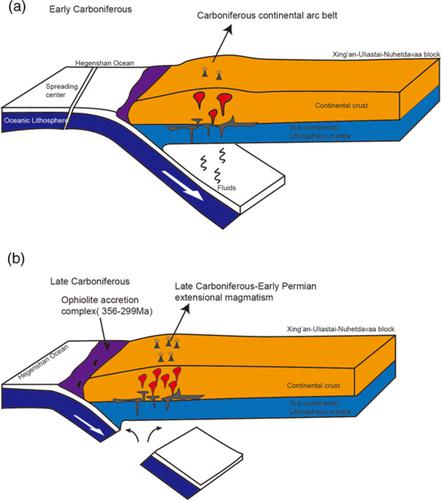当前位置:
X-MOL 学术
›
Geolog. J.
›
论文详情
Our official English website, www.x-mol.net, welcomes your feedback! (Note: you will need to create a separate account there.)
Geochemistry, zircon U–Pb dating, and Hf isotopes composition of Carboniferous granitoids in Xing'an Block, NE China: Record of slab break‐off event in eastern Central Asian Orogenic Belt
Geological Journal ( IF 1.8 ) Pub Date : 2020-12-28 , DOI: 10.1002/gj.4069 Wanli Gao 1, 2 , Zongxiu Wang 1, 2 , Leilei Li 1
Geological Journal ( IF 1.8 ) Pub Date : 2020-12-28 , DOI: 10.1002/gj.4069 Wanli Gao 1, 2 , Zongxiu Wang 1, 2 , Leilei Li 1
Affiliation

|
The Guang‐Tou‐Shan (GTS) granites, located in the Xing'an Block (XB), record Late Palaeozoic magmatism during the stage of convergence between micro‐blocks in the eastern Central Asian Orogenic Belt (CAOB). We performed a detailed geochronological and geochemical study of GTS granites intending to obtain better constraints on the subduction processes of the Palaeo‐Asian Ocean (PAO) in eastern CAOB. LA–ICP–MS U–Pb dating of zircons from GTS granitic rocks in western XB yielded emplacement ages of 332 ± 2 Ma and 301 ± 2 Ma, respectively, indicating a two‐stage emplacement process. Geochemical analyses show that the Early Carboniferous monzogranite (332 ± 2 Ma) have low values of the A/CNK and A/NK, are enriched in LILE (Rb, Sr, Ba) and LREE (LREE/HREE = 5.6–10.8), and depleted in HFSE (Nd, Ta, Zr, Hf) and P, Ti, which belong to I‐type granites. The Late Carboniferous granodiorite (301 ± 2 Ma) also displays LILE, LREE enrichment, and HFSE depletion with negative Nb–Ta anomalies, and contains relatively high Zr + Nb + Ce + Y contents (495–524 ppm) and high zircon crystallization temperature, indicating the Late Carboniferous granodiorite shows geochemical characteristics similar to those of typical A‐type granites. The two‐stage granitic rocks have εHf(t) values of +7.7 to +11.6 and yield a two‐stage depleted mantle Hf model age of 0.66–0.88 Ga, suggesting that the GTS granitic rocks were derived from partial melting of juvenile arc‐related mafic to intermediate rocks. The results, combined with regional magmatic information, indicate that the eastern CAOB experienced a subduction setting in the Early Carboniferous and extension setting in the Late Carboniferous. This change was most likely caused by the subduction slab break‐off of PAO from the Late Carboniferous.
更新日期:2020-12-28



























 京公网安备 11010802027423号
京公网安备 11010802027423号